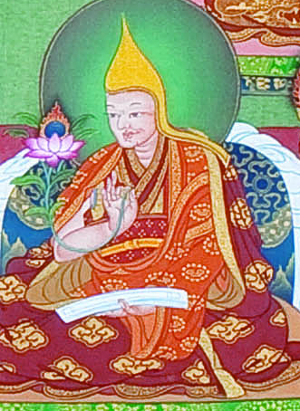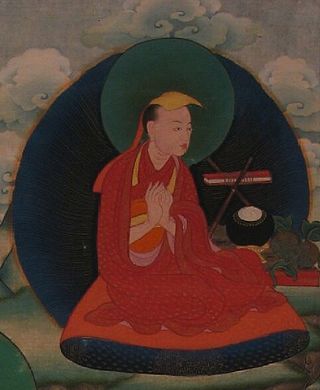
Buddhism is a minority religion in Mexico, numbering 108,701 followers or 0.09% of the total Mexican population.

Buddhism is a minority religion in Mexico, numbering 108,701 followers or 0.09% of the total Mexican population.
Casa Tibet México (headquartered in the Colonia Roma of Mexico City) was the third of the Tibet Houses to be created. [1] It was founded by the XIV Dalai Lama on his first visit to Mexico. [1] One of the main objectives of the Casa Tibet is to combat the esoteric New Age beliefs that surround eastern cosmogony and to disseminate and preserve true Tibetan culture and spirituality. [1]
The current Director, Lama Marco Antonio Karam, was chosen by the Dalai Lama to head the Casa Tibet. [1] Another important mission the Casa Tibet participates in is the sponsoring of Tibetan children located in Dharamshala, India. [1] In Mexico, they have given help to street children, Indigenous children and single mothers. [1] The Casa Tibet does not proselytize, but will not refuse an individual wanting to learn about Tibetan ideology. [1]
At a Thai Buddhist temple in Tamaulipas, there are three Buddhist monks from Thailand teaching the faith, as well as one monk from Cambodia.

Dalai Lama is a title given by the Tibetan people to the foremost spiritual leader of the Gelug or "Yellow Hat" school of Tibetan Buddhism, the newest and most dominant of the four major schools of Tibetan Buddhism. The 14th and incumbent Dalai Lama is Tenzin Gyatso, who lives in exile as a refugee in India. The Dalai Lama is also considered to be the successor in a line of tulkus who are believed to be incarnations of Avalokiteśvara, the Bodhisattva of Compassion.

Tibet is a region in the central part of East Asia, covering much of the Tibetan Plateau and spanning about 2,500,000 km2 (970,000 sq mi). It is the homeland of the Tibetan people. Also resident on the plateau are some other ethnic groups such as the Monpa, Tamang, Qiang, Sherpa and Lhoba peoples and, since the 20th century, considerable numbers of Han Chinese and Hui settlers. Since the annexation of Tibet by the People's Republic of China in 1951, the entire plateau has been under the administration of the People's Republic of China. Tibet is divided administratively into the Tibet Autonomous Region, and parts of the Qinghai and Sichuan provinces. Tibet is also constitutionally claimed by the Republic of China as the Tibet Area since 1912.

Gedun Drupa was considered posthumously to have been the 1st Dalai Lama.

Sonam Gyatso was the first to be named Dalai Lama, although the title was retrospectively given to his two predecessors.

The Gelug is the newest of the four major schools of Tibetan Buddhism. It was founded by Je Tsongkhapa (1357–1419), a Tibetan philosopher, tantric yogi and lama and further expanded and developed by his disciples.

Robert Alexander Farrar Thurman is an American Buddhist author and academic who has written, edited, and translated several books on Tibetan Buddhism. He was the Je Tsongkhapa Professor of Indo-Tibetan Buddhist Studies at Columbia University, before retiring in June 2019. He was the first endowed chair in Buddhist Studies in the West. He also is the co-founder and president of the Tibet House US New York. He translated the Vimalakirti Sutra from the Tibetan Kanjur into English. He is the father of actress Uma Thurman.
A tulku is a distinctive and significant aspect of Tibetan Buddhism, embodying the concept of enlightened beings taking corporeal forms to continue the lineage of specific teachings. The term "tulku" has its origins in the Tibetan word "sprul sku", which originally referred to an emperor or ruler taking human form on Earth, signifying a divine incarnation. Over time, this term evolved within Tibetan Buddhism to denote the corporeal existence of highly accomplished Buddhist masters whose purpose is to ensure the preservation and transmission of a particular lineage.

The Ganden Tripa, also spelled Gaden Tripa, is the title of the spiritual leader of the Gelug school of Tibetan Buddhism, the school that controlled central Tibet from the mid-17th century until the 1950s. The 103rd Ganden Tripa, Jetsun Lobsang Tenzin, died in office on 21 April 2017. Currently, Jangtse Choejey Kyabje Jetsun Lobsang Tenzin Palsangpo is the 104th Ganden Tripa.

Tibet House is an international, loosely affiliated group of nonprofit, cultural preservation organizations founded at the request of the Dalai Lama, to preserve, present, and protect Tibet's ancient traditions of philosophy, mind science, art, and culture due to the Chinese invasion of Tibet in 1950 and subsequent Tibetan diaspora. The first Tibet House was founded in New Delhi, India in 1965.

Kumbum Monastery, also called Ta'er Temple, is a Tibetan gompa in Lusar, Huangzhong County, Xining, Qinghai, China. It was founded in 1583 in a narrow valley close to the village of Lusar in the historical Tibetan region of Amdo. Its superior monastery is Drepung Monastery, immediately to the west of Lhasa. It is ranked in importance as second only to Lhasa.

Costa Rica has more Buddhists than the other countries in Central America with almost 100,000, followed closely by Panama, with almost 70,000.

The 14th Dalai Lama, known to the Tibetan people as Gyalwa Rinpoche, is, as the incumbent Dalai Lama, the highest spiritual leader and head of Tibet. He is considered a living Bodhisattva; specifically, an emanation of Avalokiteśvara in Sanskrit, and Chenrezig in Tibetan. He is also the leader and a monk of the Gelug school, the newest school of Tibetan Buddhism, formally headed by the Ganden Tripa. The central government of Tibet, the Ganden Phodrang, invested the Dalai Lama with temporal duties until his exile in 1959.
Buddhism is a minority religion in Denmark with approximately 64,000 members (1.1%) in 2018.

The Tibet Institute Rikon is a Tibetan monastery located in Zell-Rikon im Tösstal in the Töss Valley in Switzerland. It was established as a non-profit foundation in 1968, because Swiss laws resulting from the 19th century secularization movement did not allow for the establishment of new monasteries until 1973.
Geshe Tsultim Gyeltsen was a Tibetan lama and human rights activist living in the United States. Gyeltsen had been described as "one of the last living Tibetan Buddhist masters to have been trained in Tibet" before 1959.

The main religion in Tibet has been Buddhism since its outspread in the 8th century AD. As of 2022 the historical region of Tibet is mostly comprised in the Tibet Autonomous Region (TAR) of China and partly in the Chinese provinces of Qinghai and Sichuan. Before the arrival of Buddhism, the main religion among Tibetans was an indigenous shamanic and animistic religion, Bon, which would later influence the formation of Tibetan Buddhism and still attracts the allegiance of a sizeable minority of Tibetans.

Rato Dratsang, also known as Rato Monastery, Rato Dratsang is a Tibetan Buddhist monastery of the Gelug or "Yellow Hat" order. For many centuries, Rato Dratsang was an important monastic center of Buddhist studies in Central Tibet.

Khyongla Rato, also known as Khyongla Rato Rinpoche, Rato Khyongla Rinpoche, Khyongla Rinpoche, Ngawang Lobsang Shedrub Tenpai Dronme, and also as Nawang Losang, his monk's name, was a scholar and teacher in the Gelugpa tradition of Tibetan Buddhism. He was born in Dagyab county in Kham province in southeastern Tibet, and was recognized as an incarnate lama at an early age. He spent over thirty years of his life as a monk studying in the monasteries of Tibet and receiving teachings from many highly qualified lamas.
Buddhists, predominantly from India, first actively disseminated their practices in Tibet from the 6th to the 9th centuries CE. During the Era of Fragmentation, Buddhism waned in Tibet, only to rise again in the 11th century. With the Mongol invasion of Tibet and the establishment of the Mongol Yuan dynasty (1271–1368) in China, Tibetan Buddhism spread beyond Tibet to Mongolia and China. From the 14th to the 20th centuries, Tibetan Buddhism was patronized by the Chinese Ming dynasty (1368–1644) and the Manchurian Qing dynasty (1644–1912) which ruled China.

Antireligious campaigns of the Chinese Communist Party are a series of policies and practices, including the promotion of state atheism, coupled with its persecution of people with spiritual or religious beliefs, in the People's Republic of China. Antireligious campaigns were launched in 1949, after the Chinese Communist Revolution, and they continue to be waged against Buddhists, Christians, Muslims, and members of other religious communities in the 21st century. State campaigns against religion have escalated since Xi Jinping became General Secretary of the Chinese Communist Party on November 15, 2012. For Christians, government decrees have mandated the widespread removal of crosses from churches, and in some cases, they have also mandated the destruction of houses of worship, such as the Catholic Three Rivers Church in the city of Wenzhou. In Tibet, similar decrees have mandated the destruction of Tibetan Buddhist monastic centers, the destruction of sacred Buddhist sites, the destruction of monastic residences, the denial of the Tibetan people's right to freely access their cultural heritage, the ongoing persecution of high Buddhist lamas, and the ongoing persecution of Buddhist nuns and monks. Reports which document the existence of forced re-education camps, arrests, beatings, rape, and the destruction of religious sites in Tibet are also being published with regard to the Uyghur people, who are being subjected to an ongoing genocide.